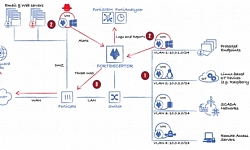Of course, that implies that the other 64% of organizations that exhibited botnet activity were impacted by other malware – highlighting the importance of stronger measures to deal with the volume and sophistication of today’s threat landscape.
With a dynamic attack surface due to the rise of IoT and cloud services, it’s clear that no one technology will be able to stop every threat. To protect your enterprise against sophisticated threats, it is important to establish a comprehensive and cohesive security infrastructure that is broad enough to cover all attack vectors, powerful enough to run the latest security technologies, and automated to keep pace with fast-moving attacks.
This is exactly what Fortinet Advanced Threat Protection delivers with its integrated, top-rated components spanning prevention, detection, and mitigation: THIS RECORDED WEBCAST EXPLAINS HOW.

Unique Benefits of Fortinet ATP Framework
Sandboxing is an important new technology to combat advanced threats. This video further outlines the unique advantages of a tightly integrated combination of technologies, unified with Fortinet threat intelligence into a complete solution, to counter cyberattacks.
Prevent: Act on known threats and information
The most efficient way to protect your organization is to immediately block a variety of known threats without impacting network performance at the network, application layer, or endpoint. This is typically accomplished with next generation firewalls, secure email gateways, web application firewalls, and endpoint security clients to stop malware, intrusions, botnets, etc.
As noted in the Threat Landscape Report conclusions, “while targeted attacks often grab the headlines, this report reminds us that the bulk of threats faced by most organizations are opportunistic in nature. Minimizing the externally visible and accessible attack surface will help you sail through many hazards unnoticed.”
Detect: Identify previously unknown threats
However, zero day attacks and sophisticated threats are often engineered to evade traditional security solutions. Advanced threat detection technologies must be added to automatically detect previously unknown threats and create actionable threat intelligence. Sandboxing in particular tests unknown items in a secure, instrumented environment to see how they behave, in order to turn the unknown into the known. Extending prevention across all layers with this deeper inspection is critical to getting ahead of the more sophisticated threats.
Mitigate: Respond to potential incidents
Once a new threat is identified, it needs to be immediately mitigated. This can be handled automatically using direct intelligence sharing between detection and prevention products, or with assisted mitigation: a combination of people and technology working together.
Further, protections from previously unknown threats can be put into place across all the layers to complete the cycle and improve the organization’s security posture in advance of future attacks.
Get End-to-end Protection with the Fortinet Security Fabric
Fortinet is the only company with independently top-rated security components—from endpoint and access through data center and cloud—designed to work together as an integrated security fabric to provide true end-to-end protection across the breadth of the organization. Our enterprise firewalls collaborate with endpoint protection, email and web application security, sandboxing, and other key offerings in the Fortinet portfolio, while offering open integration (via industry standard API’s) with third-party security products.
Not only are all Fortinet Advanced Threat Protection components powered by the leading security intelligence of FortiGuard Labs, they also leverage local intelligence dynamically generated by FortiSandbox and shared across the interconnected security infrastructure. This sharing automatically responds to the latest targeted attacks, continually improves an organization’s security posture, closes natural gaps between multi-vendor point products, and reduces the time spent managing IT security.


















































